Overview of the septic tank “Flotenk”: characteristics, operating principle, installation + analysis of modifications
In search of a suitable option for autonomous sewage, owners of private houses and cottages often choose Flotenk septic tank.
This is a reliable and convenient device that has a fairly reasonable price. In addition, the operation of such a septic tank does not require constant access to electricity.
The content of the article:
Device and principle of operation
CJSC Flotenk supplies the CIS market with an extensive range of systems for organizing autonomous sewage with its own sewage treatment plant. The assortment includes energy-dependent and electricity-independent equipment for solving various tasks of private household owners.
Externally, the “Flotenk” septic system is a cylindrical container installed horizontally or vertically. Inside, the device cavity is divided into two or three sections of different sizes.
To move the drains between the different sections of the septic tank, special overflow openings are provided in the partitions.
The first compartment is the largest and plays the role of a sump. All wastewater coming from the house is first collected here.
Effluents gradually accumulate and settle. The solid component of the effluent, as well as the contents that cannot be processed by microorganisms, accumulate below.
A greasy film is formed on the surface from those wastes that are lighter than water. During the accumulation of primary effluents, the volume of the contents of the sump increases and the liquid level rises. Over time, it reaches an overflow hole through which the liquid, partially purified during sedimentation, enters the second compartment of the septic tank.
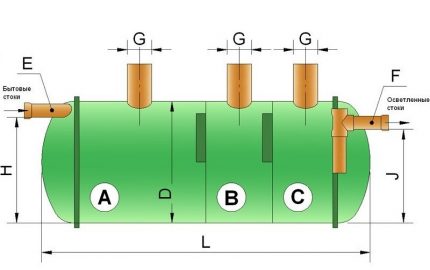
Here, microorganisms continue to work on wastewater treatment, already freed from solid fractions. As the volume of effluents in the second section of the septic tank increases, the liquid level rises again and reaches the overflow hole leading to the third section.
Here, the wastewater is finally clarified to an extent that is considered acceptable for moving the resulting fluid into the surrounding soil. To remove liquid treated effluents from a septic tank, it is necessary to create a special filtration field in the soil thickness.

To do this, at a distance from the septic tank, a series of trenches or a pit are made, at the bottom of which a sand-gravel filter is arranged. It includes layers of sand, gravel and gravel. First, a layer of filtering gravel-sand backfill is laid in the trenches, on top of which there is a system of perforated pipes - drains.
The drainage sewer system is wrapped with geotextile and filled up. Each branch of the filtration field is equipped with its own ventilation riser to remove methane formed during the processing of effluents.
Tertiary treatment with such a filter will make the resulting effluent completely safe for the environment. Moreover, the microorganisms contained in the soil aeration zone also continue the process of processing residues of substances that came with wastewater.
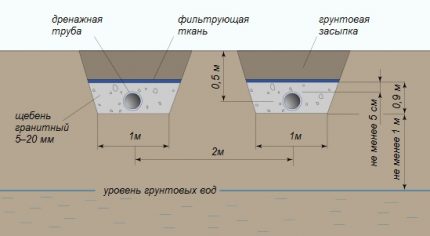
On top of each section of the septic tank “Flotenk” has an operating hole that provides constant access to the device. This provides the conditions for the successful functioning of aerobic bacteria, and also allows you to remove from the tank the gases obtained during the biological treatment of effluents.
Of course, solid waste will gradually accumulate in the sump. A significant part of them will turn into neutral sludge. The more waste, the lower the septic tank capacity, i.e. its performance. The first compartment of the septic tank should be periodically cleaned with a suction pump.
Advantages and disadvantages
The simple design and principle of operation guarantee almost complete absence of breakdowns during operation of the Flotenk septic tank. The case of the device has no seams, which provides increased resistance to both internal and external pressure.
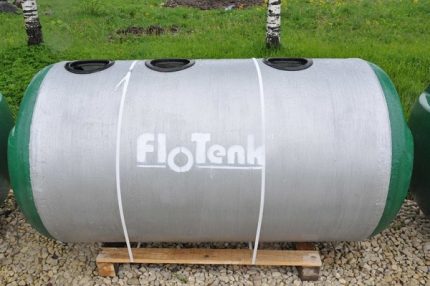
From the inside, the surface of the septic tank is made as smooth as possible. The absence of roughness makes the septic tank dirt-repellent, which allows less effort to be spent on cleaning it when removing silty sediments and non-processed waste.
Overflow pipes inside the septic tank are also made at a high quality level. They are equipped with reliable rubber gaskets providing excellent tightness. The contents of the various sections of the septic tank do not mix, which increases the effectiveness of biological wastewater treatment.
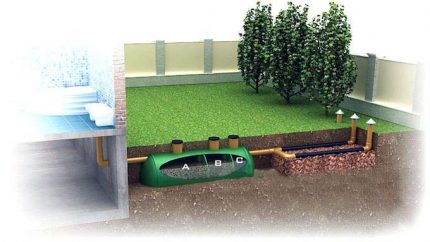
One of the main advantages of “Flotenka”, which VOCs of a higher class cannot boast of, is its non-volatility. Even a complete power outage in the house will not affect the operation of the septic tank in any way, since none of its nodes needs power supply. As a result, the costs of its maintenance are required at a minimum.
Simple installation is another significant advantage of the Flotenk septic tanks. All work on installing and connecting a septic tank can be done independently or with the help of a couple of good friends. Minimum building skills and accurate adherence to instructions will protect against errors.
The disadvantage of the septic tank “Flotenk” is the low physical weight of the device. This is convenient when transporting and installing the device, but not during its operation. Under the influence of groundwater during the spring flood or during freezing of the ground in winter, a light structure that is not filled with runoff can simply push it to the surface.
Fixing this problem is relatively easy. To do this, when installing a septic tank at the bottom of the pit, a strong concrete base is arranged. The septic tank is installed on this base and attached to it with a reliable cable.
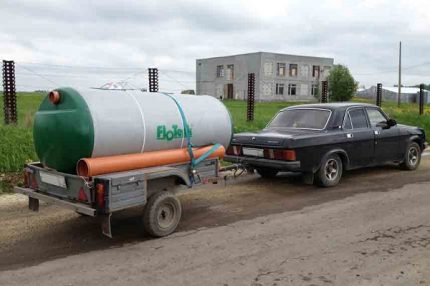
Another problem is the quality of wastewater treatment. Local treatment plants, in which wastewater is processed, can be decomposed into water and neutral sludge with a degree of purification of 96-98%. At the same time, the obtained water can be used for technical needs, for example, for watering plants on a site.
The silt accumulations in such VOCs are useful fertilizers. But the Flotenk, which is simple in design and operating principle, cannot provide such a high level of cleaning. Therefore, during its installation, it will be necessary to create and attach to the septic tank one more structure - an absorption well or a filtration field, to which water will be diverted for final cleaning.
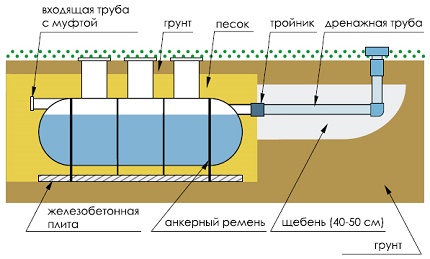
How to choose a suitable model?
The range of septic tanks “Flotenk” is quite extensive, which allows you to choose a device suitable for serving a particular house, family or even a group of houses. Septic tanks are marked with the letters STA, next to which are numbers.
The larger the number, the higher the volume and performance of the septic tank:
- Flotenk STA 1.5 processes 500 liters of wastewater per day;
- Flotenk STA 2 processes 700 liters of wastewater per day;
- Flotenk STA 3 processes 1000 liters of wastewater per day;
- Flotenk STA 4 processes 1300 liters of wastewater per day;
- Flotenk STA 5 processes 1,700 liters of wastewater per day;
- Flotenk STA 6 processes 2000 liters of wastewater per day;
- Flotenk STA 10 processes 3300 liters of wastewater per day.
In addition to performance, individual models of Flotenk septic tanks vary in size, volume and, of course, in price.
The cost of the device increases depending on its performance. The numbers will start from about 30 thousand rubles for the Flotenk STA 1.5 model, and for the Flotenk STA 5 model 90 thousand rubles will already have to be paid.
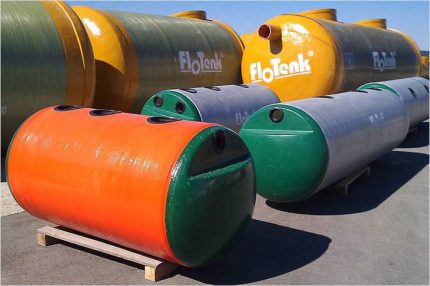
Of course, these figures may vary depending on the region, the ratio of supply and demand, as well as other factors. The specific price is best to find out directly with the supplier.
When choosing a suitable model of the Flotenk septic tank, its volume and dimensions must be taken into account, which may be:
- 1,500 l, 2,100 mm in length and 1,000 mm in diameter for the Flotenk STA 1.5 model;
- 2000 l, 2700 mm in length and 1000 mm in diameter for the Flotenk STA 2 model;
- 3000 l, 2900 mm in length and 1200 mm in diameter for the Flotenk STA 3 model;
- 3000 l, 3900 mm in length and 1000 mm in diameter for the Flotenk STA 3 model;
- 4000 l, 3800 mm in length and 1200 mm in diameter for the Flotenk STA 4 model;
- 5000 l, 2700 mm in length and 1600 mm in diameter for the Flotenk STA 5 model;
- 6000 l, 3200 mm in length and 1600 mm in diameter for the Flotenk STA 6 model;
- 10,000 liters, 5,200 mm in length and 1,600 mm in diameter for the Flotenk STA 10 model.
It should be noted that the Flotenk STA 3 model is available in two overall dimensions with the same volume and performance. The buyer can choose a model a little shorter and larger in diameter or a longer and narrower device. The length and diameter of the tank affect the size and configuration of the pit, which will be needed to install the septic tank.
The most expensive and productive model of a septic tank from the Flotenk STA 10 brand is so spacious that with its help you can serve several houses at once or even a small cottage village. Such a device is also suitable for a large cottage with a large number of residents, for example, for servicing a private hotel or a mini-hotel.
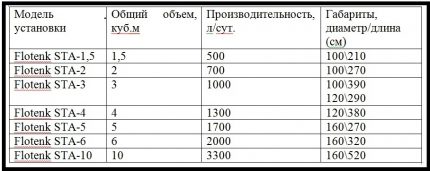
Septic tanks “Flotenk” are selected depending on the number of people who constantly live in the house. It is believed that for a small summer cottage or a family of three people, the Flotenk STA 1.5, the minimum in performance, will be an ideal choice.
The Flotenk STA 2 model is suitable for four to five people. A family of six is recommended to use the Flotenk STA 3, and the Flotenk STA 4 model is more suitable for a house with eight residents. Modification Flotenk STA 5 is designed for use in a house in which ten people live. But Flotenk STA 10 can serve the building with 17 permanent residents.
Choosing the right model, you can use simple calculations. You should multiply the estimated number of residents by 600 liters and focus on the amount received. It makes no sense to take a large-volume septic system as if “in reserve”, unless a sharp increase in the number of residents in the house is planned in the near future.
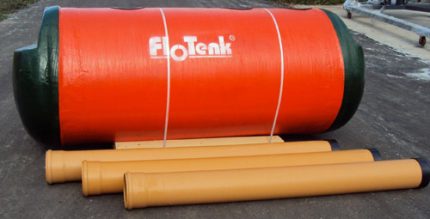
The larger the septic tank, the higher the cost of its installation, and the more difficult its maintenance. If subsequently it turns out that the tank is slightly “small”, you just have to order a vacuum cleaner to clean it a little more often. Considering that usually the Flotenk septic tank needs to be cleaned about once every one and a half to three years, this moment will not cause big problems.
Sometimes it is decided to put on the site not one, but two small septic tanks, for example, for the house and separately - for the bath. Such a decision can positively affect the quality of biological wastewater treatment, but will require additional costs. The acquisition of two septic tanks with a volume of 1.5 cubic meters. m will cost about one and a half times more expensive than buying one device with a volume of 3 cubic meters
The Flotenk STA 3 model, which holds 3000 liters of sewage, is considered the most popular. It is optimal in terms of volume and price. Its cost is four times lower than the high-performance version of the Flotenk STA 10.
Features of installation of septic tanks “Flotenk”
As previously noted, the installation of the septic tank “Flotenk” is relatively uncomplicated.
And yet, for the correct installation of the device, you will have to do a lot of operations:
- Dig a trench for the sewer leading to the septic tank from the house.
- Dig a foundation pit under the septic tank.
- Concreting the bottom.
- Lower the container into the pit and attach it to the base.
- Carry out work on the insulation of the septic tank.
- Connect a septic tank to the house sewer.
- Dig trenches for the filtration field.
- Place a sand and gravel filter in the trenches.
- Backfill the pit.
At each stage of installation, the septic tank “Flotenk” should adhere to certain standards and requirements. So, in the middle lane, it is recommended to make a trench for the sewer pipe leading to the septic tank from the house with a width of about one meter and a depth of about one and a half meters. This will allow you to lay the pipe below the level of freezing soil.
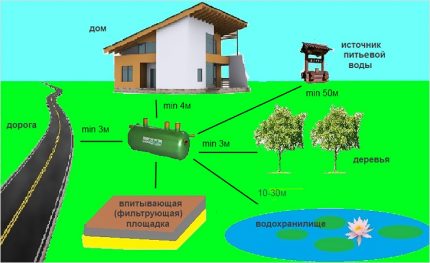
As an additional protection in case of frost, it is recommended to insulate the outer part of the sewage system. The trench should have a slight slope so that the drains move to the septic tank in a natural way. After the pipe is laid, it may be necessary to drill the foundation of the house to connect the outer and inner part of the sewer system.
The diameter of the hole should correspond to the parameters of the sewer pipe. The standard size of such communications is usually 160 or 110 mm. Now you can start digging a pit to install a septic tank. Its overall dimensions and configuration are determined by the parameters of the septic tank.
600-1000 mm should be added to the length and diameter of the container. For example, for the Flotenk STA 1.5 model, you need a foundation pit with a length of 2700-3100 mm (2100 mm + 600/1000 mm) and a width of 1600-2000 mm (1000 mm + 600/1000 mm) and a depth of 1400 mm (1000 mm + 400 mm )
The depth of immersion of a septic tank is calculated as its height (i.e. the diameter of the container) plus another 300-400 mm. In our example with the Flotenk STA 1.5 model, the pit depth will be 1300-1400 mm (1000 mm + 300/400 mm).
The foundation pit in which the septic tank will be installed should provide a place for a concrete base under its capacity and allow connection to the sewage system at the correct height.
After the pit is ready, you can take care of creating a filtration field. It is a series of parallel trenches with a filter laid inside and perforated pipes. The purified water from the septic tank will flow through pipes and gradually seep into the soil through a filter.

Usually they do not one, but several such trenches. Their length should be sufficient so that the septic tank is timely released from the liquid, which will prevent its overflow. The length of the trenches of the filtration field is calculated as follows: the number of residents in the house is multiplied by 8-10 m.
So, for a family of three, you will need a filtration field 24-30 m long. The farther these pipes go from home, the better. At the bottom of the trench you need to lay a filter consisting of layers of sand, gravel and / or crushed stone. Sometimes, instead of sand, agrofibre is used, on top of which crushed stone is poured and leveled, the layer thickness should be about 400 mm.
Plastic sewer pipes are laid in the trenches, along the length of which perforation is performed. Now you should concrete the bottom of the pit for the septic tank. First, a 200 mm thick sand cushion is laid, tamped and leveled to the bottom.
From above mount a reinforcing lattice with a cell of 200 mm. Parts of reinforcement near the edges of the pit are made longer and give them a loop-like shape.
In the future, these loops will become places of attachment of the septic tank to the base. After that, the base is poured with a cement-sand mixture. Installation of the septic tank can only be continued after the base has solidified solidly. Do not rush, so as not to violate the integrity of the fill.

Now the septic tank is lowered into the pit and attached to the base hinges using pieces of steel cable. Before starting backfilling the foundation pit with soil, it is necessary to fill the septic tank with water. If this is not done, then the mass of soil during backfilling can simply crush the walls of the device.
First, the soil is filled up to the level at which sewage and filtration pipes are connected to the septic tank. Then connect these pipes. Above each compartment of the septic tank there is a service channel. They should wear special sockets.
After that, you can finally fill up the foundation pit and sewer pipe. On the filtering field, the pipes are first covered with a layer of crushed stone (400 mm), and then crushed stone is covered with another layer of agrofiber. After that, they are also covered with soil. Now the water from the septic tank can be removed and start its operation.
Conclusions and useful video on the topic
This video illustrates the stages of wastewater treatment in the Flotenk septic tank:
This video allows you to get an idea about the quality of products manufactured at the Flotenk plants:
Septic tank “Flotenk” - moderate in price and a reliable choice for home, cottage or cottage. With proper installation and operation of such a device for many years, solve the problem of waste disposal.
And which option and brand of septic tank did you choose to equip your own suburban area? Tell us what was the decisive argument before making a purchase. Please write comments in the block below, share useful information and photos on the topic of the article, ask questions.

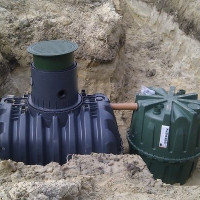 Septic tanks “Cleaners”: device, principle of operation, an overview of popular modifications
Septic tanks “Cleaners”: device, principle of operation, an overview of popular modifications 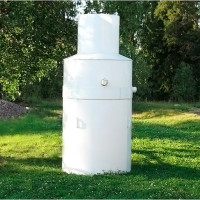 Overview of the cedar septic tank: device, principle of operation, advantages and disadvantages
Overview of the cedar septic tank: device, principle of operation, advantages and disadvantages 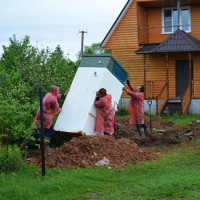 Overview of the Eco-Grand septic tank: device, principle of operation, advantages and disadvantages of the system
Overview of the Eco-Grand septic tank: device, principle of operation, advantages and disadvantages of the system 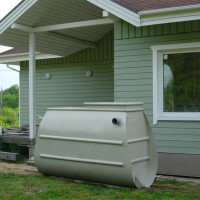 Overview of the Tver septic tank: device, principle of operation, advantages and disadvantages
Overview of the Tver septic tank: device, principle of operation, advantages and disadvantages  Overview of the septic tank “Sunrise”: characteristics, model range, installation rules
Overview of the septic tank “Sunrise”: characteristics, model range, installation rules 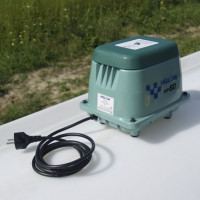 Compressor for septic tank: principle of operation, how to choose + operating rules
Compressor for septic tank: principle of operation, how to choose + operating rules  How much does it cost to connect gas to a private house: the price of organizing gas supply
How much does it cost to connect gas to a private house: the price of organizing gas supply  The best washing machines with dryer: model rating and customer tips
The best washing machines with dryer: model rating and customer tips  What is the color temperature of light and the nuances of choosing the temperature of the lamps to suit your needs
What is the color temperature of light and the nuances of choosing the temperature of the lamps to suit your needs  Replacement of a geyser in an apartment: replacement paperwork + basic norms and requirements
Replacement of a geyser in an apartment: replacement paperwork + basic norms and requirements